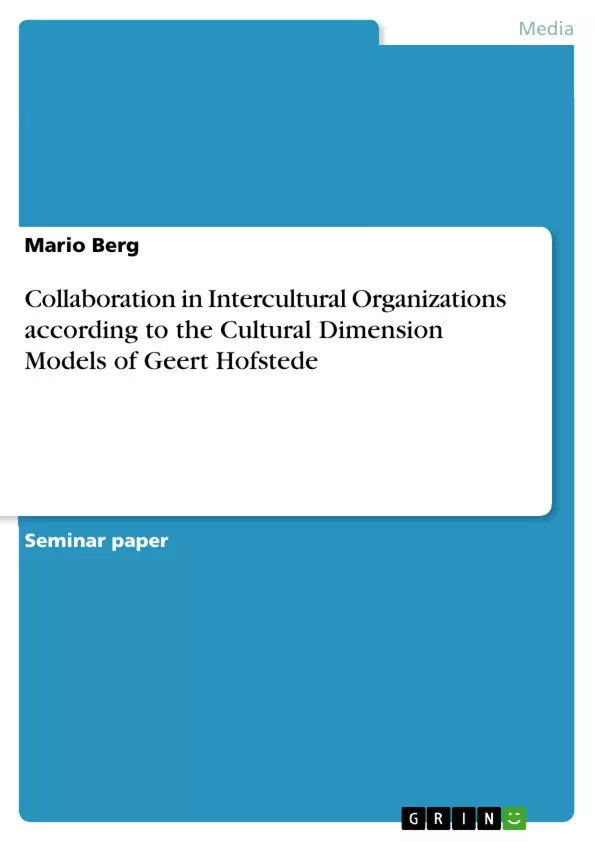Every society has her culture, but within a society are many people with a variety of values and perspectives. How can a culture then be dimensionized? And, what is a society in this relationship? The later explained dimensions from Geert Hofstede are oriented along nations, but it would result in a cliché dictionary when culture dimensions would be restricted to the nation level. The culture of a society is mostly perceived by the communication. „Culture is communication and communication is culture.“ (Edward T. Hall) This communication does not mean the spoken word; it is rather about of how the universal circumstances of life are represented in the communication.
Inhaltsverzeichnis (Table of Contents)
- Introduction
- Cultural Dimensions and Models
- Dimensionizing of Cultures
- History of the Hofstede Dimensions
- The Hofstede Dimensions of Cultures
- The Hofstede Dimensions of Organisational Cultures
- Collaboration in Intercultural Teams
- Communication
- Attitude
- Culture Dimensions for Germany and the United States
- Common Values
- Different Values
- Summary
Zielsetzung und Themenschwerpunkte (Objectives and Key Themes)
This work aims to investigate the causes of communication conflicts in intercultural teams, specifically focusing on the communication between North Americans and Europeans, using Hofstede's cultural dimensions as a framework for analysis. The study explores how differing cultural values impact workplace interactions and lead to misunderstandings despite a shared language.
- Cultural Dimensions and their impact on communication
- Analysis of communication conflicts in intercultural teams
- Application of Hofstede's cultural dimensions to North American-European interactions
- Identifying cultural differences affecting workplace dynamics
- Exploring the limitations of cultural dimension models
Zusammenfassung der Kapitel (Chapter Summaries)
Introduction: This introductory chapter sets the stage by illustrating the prevalence of communication conflicts within multinational corporations, even when a common language is used. It highlights a specific case within a US-based company with German and American employees to demonstrate the problem. The chapter introduces Hofstede's cultural dimensions as a potential explanatory model for these conflicts and outlines the study's focus on the communication between North Americans and Europeans.
Cultural Dimensions and Models: This chapter delves into the complexities of defining and measuring culture. It explores various theoretical approaches to understanding cultural differences, highlighting the limitations of simplistic national-level classifications. The chapter introduces several prominent models for categorizing cultural values, including those proposed by Edward T. Hall, Talcott Parsons and Edward Shils, Florence Kluckhohn and Fred Strodtbeck, and Mary Douglas. The chapter critically examines these approaches, emphasizing the subjective nature of these models and the challenges of applying them broadly.
Schlüsselwörter (Keywords)
Intercultural communication, Hofstede's cultural dimensions, communication conflicts, cross-cultural management, North American-European relations, organizational culture, cultural values, high-context vs. low-context communication.
Frequently Asked Questions: A Comprehensive Language Preview
What is the main topic of this text?
This text is a comprehensive preview of a work investigating the causes of communication conflicts in intercultural teams, specifically focusing on communication between North Americans and Europeans. It uses Hofstede's cultural dimensions as a framework for analysis.
What are the key themes explored in the text?
The key themes include the impact of cultural dimensions on communication, analysis of communication conflicts in intercultural teams, application of Hofstede's model to North American-European interactions, identification of cultural differences affecting workplace dynamics, and exploration of the limitations of cultural dimension models.
What is the structure of the text?
The text provides a structured overview including a table of contents, objectives and key themes, chapter summaries, and keywords. It begins with an introduction highlighting the prevalence of communication conflicts in multinational corporations, even with shared languages. It then delves into cultural dimensions and models, focusing on Hofstede's model, before summarizing its key findings.
Which cultural dimensions models are discussed?
The text mentions and critically examines several prominent models for categorizing cultural values, including those proposed by Edward T. Hall, Talcott Parsons and Edward Shils, Florence Kluckhohn and Fred Strodtbeck, and Mary Douglas, while placing a significant emphasis on Hofstede's dimensions.
What specific case study is mentioned?
The introduction mentions a specific case within a US-based company with German and American employees to illustrate communication conflicts arising despite a shared language.
What are the limitations of cultural dimension models addressed in the text?
The text acknowledges and discusses the subjective nature of cultural dimension models and the challenges of applying them broadly, highlighting the limitations of simplistic national-level classifications.
What are the key takeaways or conclusions of the text?
The text aims to provide a comprehensive overview of the challenges of intercultural communication, particularly focusing on the impact of cultural differences on workplace interactions between North Americans and Europeans and the usefulness and limitations of frameworks like Hofstede's model in understanding and addressing these challenges.
What are the keywords associated with this text?
The keywords include intercultural communication, Hofstede's cultural dimensions, communication conflicts, cross-cultural management, North American-European relations, organizational culture, cultural values, and high-context vs. low-context communication.
- Citar trabajo
- Mario Berg (Autor), 2015, Collaboration in Intercultural Organizations according to the Cultural Dimension Models of Geert Hofstede, Múnich, GRIN Verlag, https://www.grin.com/document/295365



